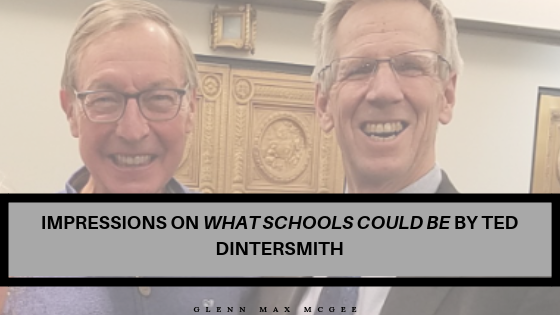Three years ago, I met Ted Dintersmith when I was an invited panelist at the screening of the terrific film he produced, Most Likely to Succeed. The film’s insights into the challenges, opportunities, potential, and fulfillment of inquiry driven project focused teaching and learning inspired both my work in my own district and support for others with the courage to embark on innovative practices quite unrelated to testing and standard metrics. Just last month I had the opportunity to re-engage with Ted when he was through town to speak with Chicago Public School teachers (free of charge I might add!) and to check out the video clips on his Innovation Playlist (https://teddintersmith.com/innovation-playlist/) that show small interventions that lead to big changes.
I have taken a lot of road trips in my time, but Ted’s 2015 adventure is one for the ages. He would have easily won my college fraternity’s Ripon Award for the most outrageous spontaneous road trip (the current record holder was my roommate Bill “Mouse” Anderson who left Dartmouth one night in 1970 and drove straight through to UC Berkeley to see his high school heart throb … but that story is a blog in itself for another time). Originally on a mission to show teachers how to teach effectively and prepare students for this new world of technology, his mission changed once he began stepping foot into classrooms and became determined to visit schools in all fifty states. Ted took an entire school year to visit 200 schools in Alaska, Hawaii, and the lower 48. He conducted more than 100 community forums and was patted down 68 times by TSA.
Of the many findings and conclusions Ted reached, two especially struck me: 1) Leaders who trust teachers to innovate and pursue their expertise and passion with the classes have outstanding results by every metric and 2) students thrive in PEAK environments, i.e. schools and classrooms with Purpose, Essentials, Agency and Knowledge.
Before we unpack Ted’s conclusions, we should consider the history of American schooling. Ted writes that schools in 2018 straddle two contexts: their 19th education model and their 21st century dynamic world. It is a constant tug of war between the past and future. Moreover, although the 1954 Brown v. Board of Education Supreme Court Case stated that education “is a right which must be made available to all on equal terms,” that is not what Ted found taking place in schools along his journey. The stratification between facilities and funding in rich and poor schools and differences opportunity and access by zip code are beyond alarming. That said, schools that have a PEAK culture, fostered by trusting leaders have children who flourish and graduates who can and will ensure a bright future for us all as they tackle and solve our country’s toughest challenges.
Throughout his journey, Ted consistently saw that when administrators trust, encourage and support innovative teaching, students and schools thrive. These teachers feel empowered to teach to their personal passions, adjust the curriculum based on their personal expertise and experiences, and immerse students in projects and problems. Each story is inspiring, and having read the book, my most fervent wish is that our four grandchildren – and for that matter all children – have PEAK schools with caring, trusting and trustworthy leaders.

